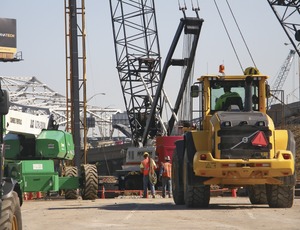
Virtual-reality tools and ramped-up deadline goals are propelling the $2.6-billion Ohio River Bridges project out of the starting gate. Workers are driving piles now to reconstruct the ramps for the John F. Kennedy Memorial Bridge and the interchanges at which Interstate 65, I-64 and I-71 intersect in Louisville, Ky.
The interchange work is a $425-million portion of the project, which will entail building a second bridge that will carry northbound traffic, doubling the so-called Downtown Crossing's capacity to and from southern Indiana on I-65. The existing bridge will carry only southbound traffic when the project is complete. A new East End Bridge will be located 10 miles from downtown Louisville and connect the Gene Snyder Freeway to the Lee Hamilton Highway.
Walsh Investors is teamed with France's Vinci Concessions and Bilfinger Berger PI International Holding GmbH in a public-private partnership (P3) for the $760-million East End Crossing. Walsh also leads a design-build team for the Downtown Crossing. For the latter crossing, the team's best-value bid "included a cost of $860 million and a projected completion date of Dec. 10, 2016, over 18 months earlier than the June 30, 2018, requirement," Walsh said in a statement.
Indiana is administering the P3, while the Kentucky Transportation Cabinet (KTC) awarded the design-build contract. Walsh's team will try to earn up to $12 million in bonus awards—or $40,000 a day—for completing construction early. The penalty is $80,000 for each day the project is late.
Bank-to-Bank Cooperation
Kentucky and Indiana assumed joint responsibility for administration and financing to facilitate the fast pace. "Kentucky and Indiana have different procurement laws, and each state played to a strength—Indiana to a P3 with availability payments, Kentucky to a design-build with mostly bond financing," says Chuck Wolfe, KTC spokesman.
Work jumped into overdrive after contracts were awarded last November. Site work crews mobilized at a moment's notice, says Dan Kucza, Kapur Associates.The Milwaukee-based subcontractor is providing surveying for the Downtown Crossing, using cutting-edge technologies on a scale new to the firm. "Sketches and plans are being uploaded to the cloud as they are finished," Kucza says. "Crews see the latest and greatest plans immediately and can regroup if something needs to be done right away."
Kapur is using "mobile lidar" to plot the entire landscape of construction. "It's a million-dollar machine that images the entire job. It plots about a million points per second and creates a virtual reality of the entire jobsite. If the contractor needs to move a crane in the middle of the night, it knows what route to take and if it will fit under overpasses and power lines," Kucza says. "They can create a report with the dimensions and be certain that it won't get stuck." Plans are uploaded to the cloud and distributed to crews' iPads. Kucza says Kapur has used the technology before, but not to such an extent.
Louisville, dubbed the "Gateway to the South," hosts the intersection of three major interstate highways, but its aging infrastructure has limited the city's ability to capitalize on its geographic advantage. Finding a solution was slow going. "The concept of at least one new river crossing can be found in planning documents from 40 years ago," says Wolfe.
Studies are under way to estimate the toll revenue from projected use. Insufficient revenue from tolls would result in a higher risk profile and lower bond rating, adding millions in financing costs. KTC's Wolfe says the state is confident it will receive an investment-grade rating.

Post a comment to this article
Report Abusive Comment